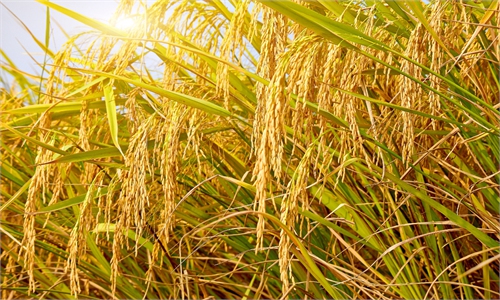China purchases over 400m tons of grain from farmers in 2023, securing national food reserves

This aerial photo taken on Oct. 19, 2023 shows a villager drying harvested corns at Dongsheng Village of Zhaodong City, northeast China's Heilongjiang Province. Heilongjiang has remained China's top grain producer for 13 consecutive years. The total grain output of Heilongjiang accounted for 11.3 percent of China's national grain output in 2022.(Photo: Xinhua)
China produced a bumper grain harvest in 2023 and maintained stable purchases at more than 400 million tons, despite extreme weather conditions. This laid a solid foundation for stable grain supplies, according to a national work conference on food and strategic reserves held on Monday and Tuesday.
Analysts said that grain purchases are a form of macro-control over the country's grain reserves, which are crucial to national food security as they ensure supplies nationwide and guarantee farmers' interests.
China's grain inventories are abundant, with its stock-to-use ratio well above the international grain security threshold of 17-18 percent, Liu Huanxin, head of the National Food and Strategic Reserves Administration, said at the conference.
"The administration strengthened macro-control over grain reserves in 2023 to offset the domestic impact of fluctuating international grain prices," said Liu.
Market-oriented transactions dominate China's grain purchases, with policy-based purchases acting as a supplement, analysts said.
Market-based purchases mean that grain prices are decided by the market, and grain buyers can directly purchase grain sold by farmers at market prices.
Policy-based purchases set price floors for wheat and rice in major producing provinces to protect farmers' interests, analysts said.
Liu warned that although China has had good grain harvests for a number of years, the crops are concentrated in main producing areas. The pressure of large-scale, long-distance and rapid transport and supply is increasing.
"China will enhance coordination in grain production, purchases, stockpiling and sales in 2024. The country will launch the minimum grain purchase price plan promptly and actively respond to emergencies such as disasters and extreme weather, so that farmers will not lose money," Liu stressed.
What China aims to improve is its grain production capacity, which refers to the capacity to produce, store, transport and process food when needed, rather than the simple pursuit of grain output as took place in the past, Wang Gangyi, a professor at Northeast Agricultural University, told the Global Times.
Ensuring grain purchases is an effective way to guarantee national-level grain storage, analysts said.
"The capacity of standard warehouses nationwide has reached 700 million tons, and the standardized, refined, green and intelligent level of grain storage management has continuously improved. Overall storage conditions remain at a world-leading level," said Liu.
China improved the management of its grain reserves in 2023, with digital management completely realized in all provincial-level warehouses and county-level warehouses in 29 provinces, according to the National Food and Strategic Reserves Administration.
Wang said that increasing the country's grain production capacity sustainably can be realized through cultivating high-quality varieties, adopting standardized high-yield and high-efficiency green technology models, and promoting mechanized harvesting to reduce losses.
Global Times



